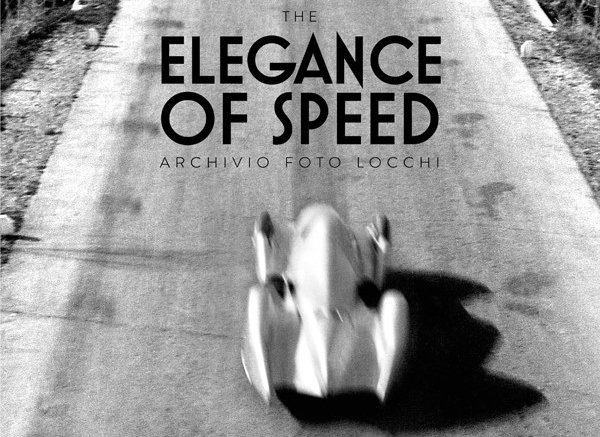The Elegance of speed. Archivio foto Locchi
From June 12 to September 16, the history of the car in Florence and Tuscany through the unique shots of Archivio Foto Locchi
The charm of the world of cars, defined by dust and speed, endeavours to the limits of possibility and a passion that can change one’s life. A world built by men who seek to outdo themselves day after day.
This world, in its entirely Italian elegance, is recounted until September 16 in the rooms of Palazzo Pitti through photographs from the Archivio Foto Locchi, thanks to the director of the Uffizi Galleries Eike Schmidt, who welcomed the initiative and, for the occasion, wrote the preface to the exhibition catalogue, titled The Elegance of Speed, prepared and designed by Gruppo Editoriale and the Archivio Foto Locchi.
A new chapter in the history of Florence and Tuscany is interpreted through the photos that seared into the collective imagination the faces of drivers sculpted by the sun and the futuristic elegance of their cars’ designs. The exhibition curated by Alessandro Bruni, Erika Ghilardi and Matteo Parigi Bini retraces the important moments in this Tuscan undertaking.
It was Tuscany that, with its beautiful roads, was home to the gradual development of a network of circuits (Circuito del Mugello, Coppa della Consuma, Circuito delle Cascine, Circuito di Firenze, Firenze-Fiesole), igniting the passion for speed and the mastery of race car drivers. And Florence, the city where Barsanti and Matteucci created the first internal combustion engine, patenting it in 1853, where the second automobile in Italy (1894) took to the streets and, in 1901, where the Giro d’Italia Automobilistico passed through. They were cult objects aimed at the elite and they would remain so for many decades. So much so, that half a century later, in the Boboli Gardens behind Palazzo Pitti (the same location of the exhibition), the city dedicated an emblematic event to automobiles that paid tribute to their aesthetics, the I Concorso d’Eleganza, held in 1948.
Divided into three sections, one dedicated to races in the region, one to the Concorsi d’Eleganza and one to the drivers that with their courage changed the history of man and its rapport with time and speed, the rich exhibition captures our eye and fantasy with its timeless black and white shots and for the worlds we can explore through them. The races that sped across the soft curves of the Tuscan landscape and the ruggedness of its borders marked the history of speed because it was in 1934, one biting November day on a stretch of the Firenze-Mare highway between Badia a Pacciana and Canapale, that the engineer Giuseppe Furmanik achieved a new record for the flying start in the 1,100-cc class on board a Maserati 4CM, with a speed of 222.634 km/h, beating the record previously held by George Eyston on an MG.
Not three months later, technicians at the future AUDI attempted to beat Furmanik’s record with the Polish-German Hans Stuck behind the wheel of a Typ B. The attempt was indeed a success, with Stuck reaching an astonishing 317 km/h, wiping every previous record off the map, while the car became known as the Typ Lucca.
A photo of Stuck with his wife wrapped in a long animalier fur jacket reveals a universe that’s still legendary today. But that wasn’t the end, because in June that same year, Tazio Nuvolari, with a dual-engine Alfa Romeo prepared by Drake, exceeded 300 km/h, and for the flying start, he reached 323.175 km/h, all while wearing a simple uniform and a white helmet… because really, it was only a test after all.
The drivers, which are highlighted in the exhibition with precious mementos like helmets and uniforms, together with a miniature bolide that Ferrari prepared for his son Piero in the workshops in Maranello, are at the centre of a section that tells of the men that were in love with speed and the mechanic horses that in the 20th century had no need for breaks, at least not when Mantua native Nuvolari was behind the wheel, the fastest man in Italy.
Alongside him are the elegant Giannino Marzotto, who drove wearing a dress shirt, jacket and tie, and the Thai Prince Bira, who in addition to the Formula 1, participated in four Olympics as a yachtsman; but there’s also the aristocrat Felice Trossi, who raced cars and yachts without ever losing his “brilliant and detached self-confidence,” or the fearless, superstitious Ascari, who died the only day he left his house without the helmet he always wore. The history of these drivers (which includes just one woman, the noble Maria Teresa de Filippis, known as Pilotino and who abandoned racing when the colleague that replaced her at the last minute for a competition died in the race) is the history of the 20th century sui generis, the images of which depict the changing costumes, places, fashions and faces of the enthusiasts.
The third section is dedicated, naturally, to style, that of the automobiles themselves. The Concorsi d’Eleganza were a unique moment in this four-wheeled adventure, serving first as displays of elegance but which later became a place to present new cars and products.
The exhibition, was made possible thanks to a contribution from the Fondazione CR Firenze, which for the second time was committed to the promotion and communication of such an important archive, as well as support from K-array, a producer of high-end distribution systems and management of professional audio equipment, based in the Mugello, featured in the exhibition with a sophisticated audio system, and Caffè Gilli, a gathering place in Florence since 1733 that appears more than once in the photos conserved in the Archivio Foto Locchi.









